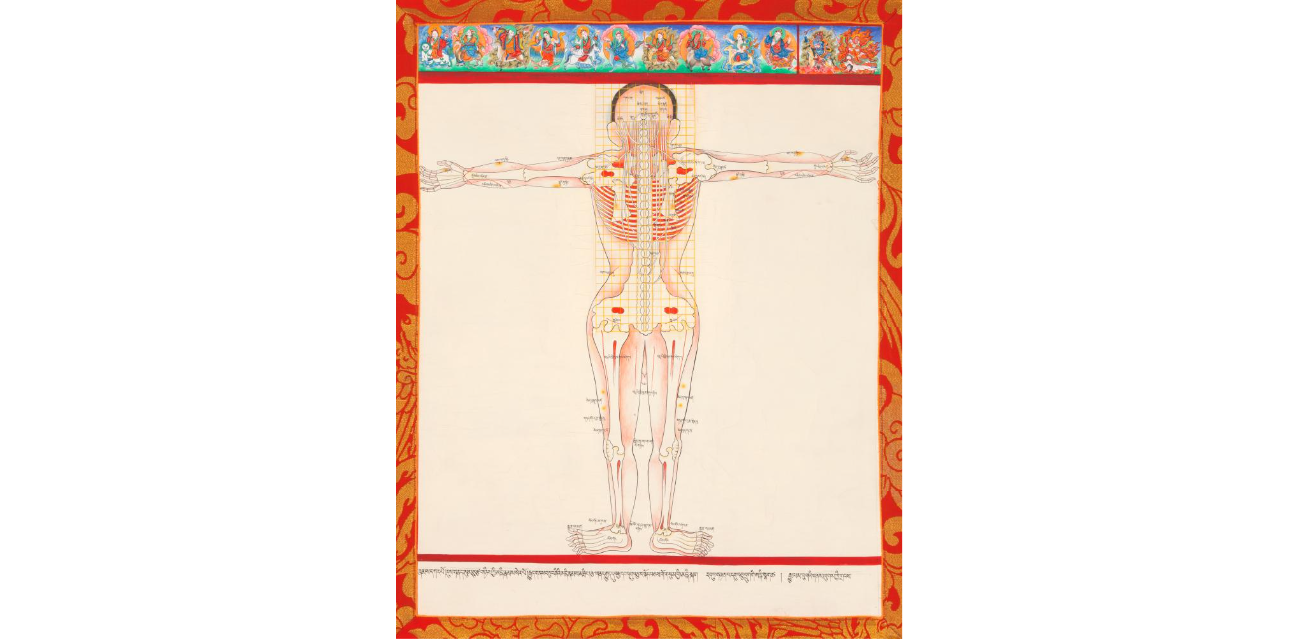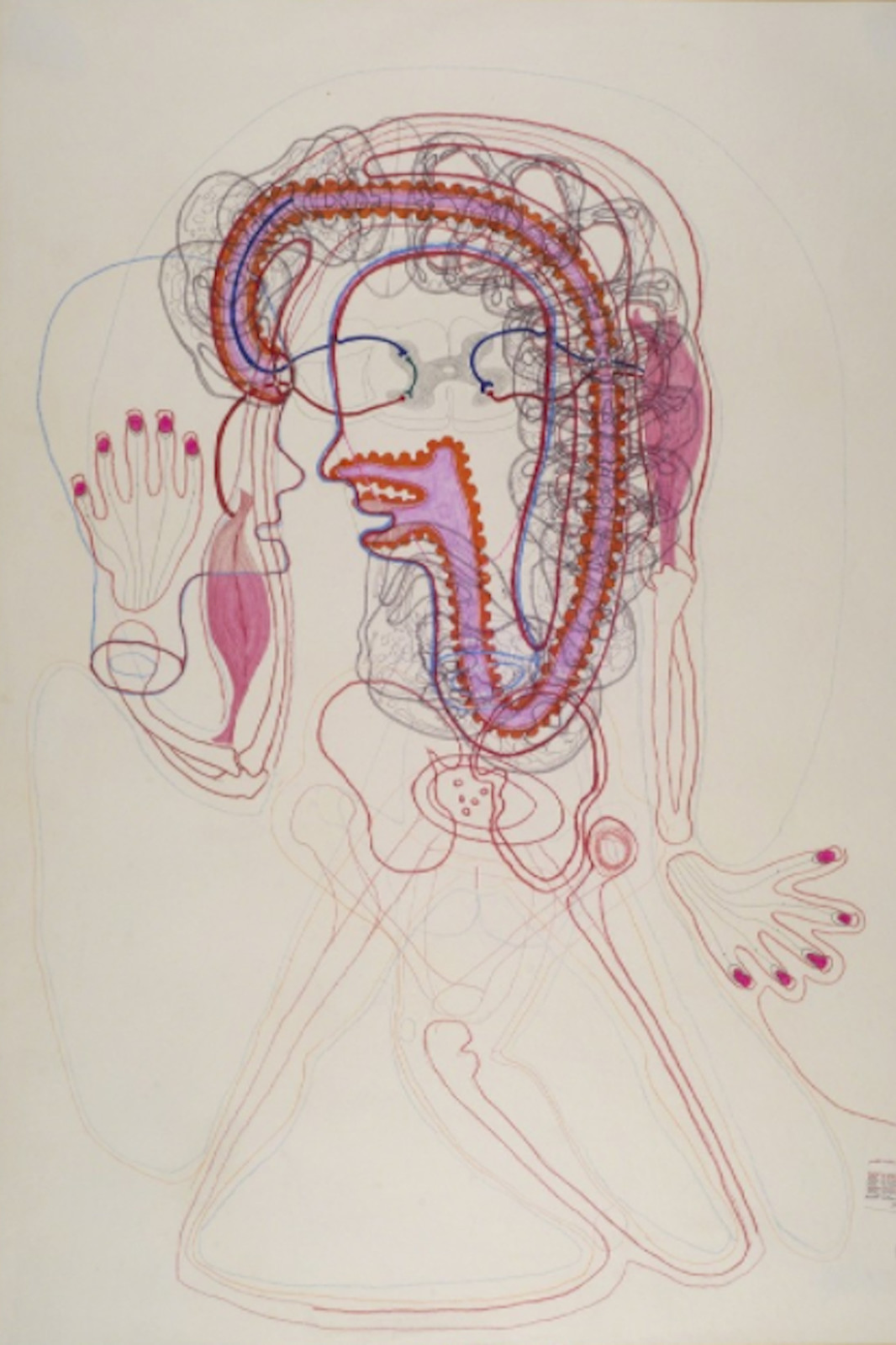In the West art and anatomy have a long association; they are entangled together, which I suppose was a necessary condition as the ability to render objectively accurate images of the body necessitated artists study anatomy. Dissection of humans however was largely forbidden in the ancient world, but early medical thinkers such as Galen and Vitruvius were still able to come up with theories for how the body worked by dissecting animals, and from the information gathered, they deducted how the inner mechanics of humans worked, often by linking this knowledge to observations of exterior signs of illness such as changes in body colour and condition. This internal / external interrelationship would dominate Western thinking for centuries and in many ways still does.
Galen' s Tripartite Scheme, explaining how the blood circulated through the body

Vitruvius
Like Russian dolls, these energy fields can sit one within the other, each one similar to the others, but each one also unique and having its own features. It is in the transition space that sits between the drawing of a man and the drawing of geometry that an idea grows.
Leonardo: Vitruvian Man
Andreas Vesalius: On the fabric of the human body in seven books
In the 16th century the physician Vesalius published his influential work, 'On the fabric of the human body in seven books'. He was an anatomist as well as a doctor and in making observations from his actual dissections was able to establish that many of Galen's theories were wrong. As these 'advances' in medicine were undertaken, what they also seemed to do was develop an idea of the body as a 'mechanism' or purely physical organ, advances in representation going alongside advances in medical procedures.
However there were other traditions.
Hua Khar Jaintsa 'Course of the Lifespan Principle' (1995–96) Pigment on cloth
In 1991 the 5,000 year old body of what was to be called Ötzi the Iceman was discovered. Entombed in ice shortly after his death, the glacial conditions protected much of his tissue, bones and organs and in particular because his skin was preserved, his tattoos were too.
Ötzi the Iceman with tattoo locations
80% of the tattoos found on the iceman overlap with classical Chinese acupuncture points, in particular those used to treat rheumatism, a medical condition that contemporary forensic archeology tells us the iceman suffered from. Other tattoos were found to be located on or near acupuncture points as well. Various herbs and medicines were also found alongside his remains, all pointing to ancient medical practices, that suggest the iceman belonged to a society with a surprisingly advanced health care system.
It is instructive to compare the Iceman's medical care with Tibetan medicine, a holistic practice with an approach that focuses on the conjunction of mind, body, and spirit. Also known as Sowa-Rigpa medicine, it is an ancient medical system that employs a complex approach to diagnosis, incorporating techniques such as pulse analysis, urinalysis, behaviour and dietary observation to determine what is wrong and uses herbs and minerals alongside acupuncture to treat illness. Hua Khar Jaintsa (active 1990s), created several intriguing images whereby the principles of Tibetan medicine were explained. The image 'Course of the Lifespan Principle' clearly illustrating the relationship between acupuncture points and the way that energy flows through the body. Hua Khar Jaintsa has created a body of work that reflects on many issues related to human development as well as on medicine and it stands comparison to many western European artists who have also attempted to explain the normally hidden aspects of our bodies.
Hua Khar Jaintsa: Early Human development
Hua Khar Jaintsa: Vulnerable points
It is interesting to compare Hua Khar Jaintsa to both Alberto Morroco and Luboš Plný. Alberto Morroco was the artist who in 1949 created the images for one of the definitive anatomy textbooks.
Alberto Morroco
Luboš Plný makes anatomical images of the human body, but he is also concerned to depict its functioning, its limitations, and its mortality. Sometimes labelled “anatomical self-portraits”, he combines coloured inks with acrylic paint and collage with organic elements such as blood, hair, the ashes of his dead parents and used medical aids to depict the body. He makes precise records of skin, musculature, bones, circulatory systems, and organs, embedding his observations into montages consisting of drawings made on the basis of everything from 19th-century anatomical guides, X-ray images, photographs of Madonnas and any other medical or religious items that he comes across.
Luboš Plný
Plný seems to have intuitively understood that as in Buddhist influenced health practices such as those practiced in Tibet, India, Nepal Siberia, China and Mongolia, healing is about confronting and transforming suffering and rebalancing the mind and body to equilibrium and not about waiting until someone is sick, so that you can then cure them. This equilibrium is something the body itself is constantly seeking to achieve, using its hormone systems to effect change when it senses things are out of balance.
Hormone Map
A brief look at a hormone map gives you an idea of the complexity of the body's feedback mechanisms. It also gives a chemical insight as to why an unhealthy body can affect mental health, and how poor mental health can affect the state of the body. The energy field that moves between the body and mind is called in Tibetan medicine 'duawa' and this is shaped by a combination of environment, diet, history, behaviour and belief system. For instance it is believed that if we eat the wrong foods, they can accumulate in our bodies and eventually manifest as illness. In terms of my understanding of what my own art practice is and what it could be, it has been important to understand that historically Tibetan artists created powerful images that were used as practical guides for well-being.
Tibetan Buddhist paintings of medical issues are used to help people understand the relationship between their condition and treatment, these images can combine physical, mental and spiritual conditions as well as illustrate how treatment could help them. This is a step beyond the work of a medical illustrator, and would seem to me to incorporate medical illustration with religious art, conceptualism and expressionism.
This fusion of various different disciplines offers for an artist such as myself a lot of freedom, whilst at the same time giving me a sense of purpose, especially as I continue my search for a way to visualise various forms of interoception. Here is another image, this time taken from an illustrated handbook of reflexology. The image of feet also has depicted within it images of the various parts of the body that are interconnected to them by energy flows which are themselves stimulated into action by applying pressure onto particular areas of the soles of your feet.
Acupuncture reflexology
The conjunction of images suggests a fluid liquidity of an embodied understanding, that compresses head, lungs, stomach and heart into a body that can exist within the flattest flatness of flat feet.
Holbein: Dead Christ
I am interested in a way of making images that combines Holbein's veracity, with an acupuncture reflexology diagram, with a chemical stain, with architectural space, with an emotive mark making system and a conversation between two people whereby they agree that a feeling tone can be not only depicted, but in that depiction captured and therefore externalised and making it available to healing rituals. As I struggle to find the right approach, I as always look around for artists that I think have developed a practice that feels as if it is hitting a spot at least near to where I would like to be. For instance Palden Weinreb, a New York–based artist draws on Buddhist teachings in his art practice, he makes works that help us to regulate our body rhythms. In the work below a pulsing white light brightens and dims in echo with our breathing patterns, encouraging deeper, more thoughtful, slower breaths. These regulated breaths may well have physical, psychological, and emotional benefits. He is essentially making a mandala within a mandala, a cycling light sits in the centre of a series of nested half spheres, the artwork as it pulses operating as an instrument for meditation.
Palden Weinreb
Weinreb's work is though but an echo of a very old Tibetan tradition, which includes the making of mandalas that have now been produced by anonymous artists for hundreds of years. These artefacts are though rarely to be seen on their own and would normally be accompanied by prayer or some other ritual.
Tibetan Mandala
There can be constructed between any two things a hybrid, therefore different aspects of the representation of humanity can be brought together, non figurative or more abstract images can be brought together with representation, sometimes to instruct and at other times to provide images that help foster moments of reflection or meditation. These hybrid forms are I believe necessary ones, because they allow imagery to operate across boundaries and to link together previously separate concepts.
From a series of images developed initially as foot votives
Colour and light would appear to me to be central to the way we develop metaphor, light in particular has often been used to provide a gateway into spiritual reflection.
Fused glass: Lower leg insect bites
I have looked at drawing with light in the past, and I have more recently been made aware of the healing power of both colour and light. 'Colour halls' were used for healing in ancient Egypt, China and India and I still remember first coming across SAD lights in a restaurant in Glasgow some years ago, and finding out then how much a lack of sunlight in winter effected northern people's circadian rhythms.
The various energy fields that move between the body and mind can all be thought about and reflected upon within the process of image making. Some of these processes will have historically belonged to the realm of religious imagery, others to more general ideas of spirituality but others have now entered the world of contemporary medical practices. Whether these issues are seen as belonging to art as therapy, or to art as a focus for meditation and a doorway into spiritual enlightenment, or simply as a way to use our hands and making skills as route into good mental health, I do think that we ought to be far more aware of art's potential to become once again part of the essential wellbeing of life.
See also:























A 4-day tour of Morocco will allow you to experience some of the most outstanding and varied aspects of this beautiful country. Here you have a possible itinerary for a tour marruecos 4 dias:
ReplyDeleteI never thought I'd enjoy a truck simulator gamerzone, but delivering goods across virtual landscapes is oddly satisfying.
ReplyDeleteSuch an amazing set of diagrams you have sketched. Nowadays kidney transplants are possible with the latest technologies which were thought to be nearly impossible. Before doing a transplant you can clear your doubts over here at how long does a kidney transplant last.
ReplyDeleteThat is indeed an amazing drawing. The sketch is nicely detailed and labeled. Such drawings and sketches are still used to know and train doctors to perform complicated procedures like kidney transplant procedure or other organ transplant procedures.
ReplyDelete